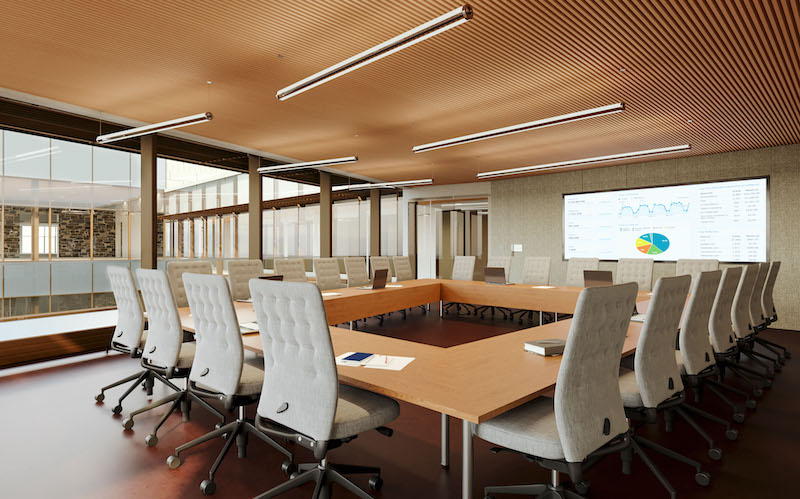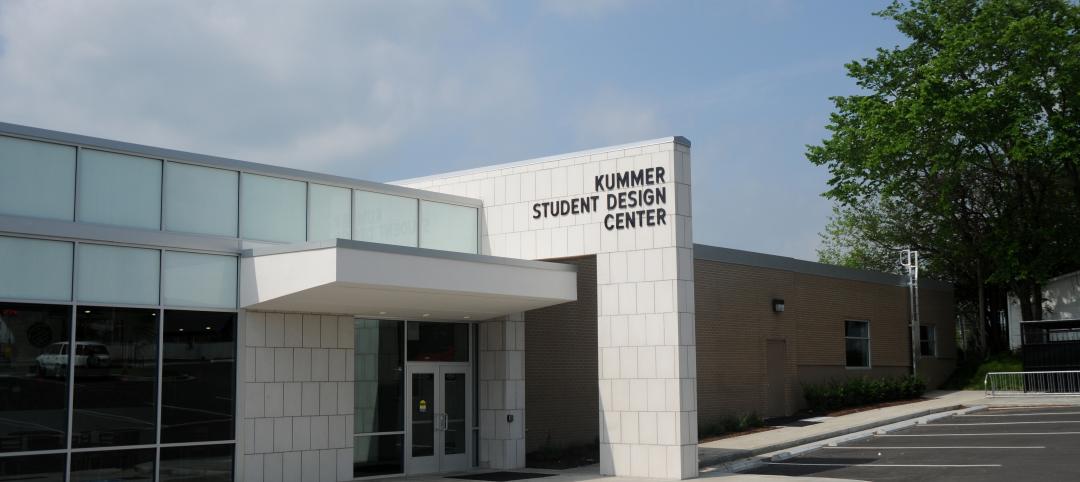On April 1, construction began on a three-story, 74,000-sf expansion of Lehigh University’s College of Business in Bethlehem, Pa. This project was supposed to begin last year but got delayed by the COVID-19 outbreak. The building is scheduled for completion in the Fall of 2022.
Since the Rauch Business Center opened in 1991, the College has seen a 43% increase in enrollment and 38% increase in faculty. New programs and courses of study have been added, including a FinTech minor, interdisciplinary initiatives majors and executive education.
According to Lehigh, the new building—which replaces a parking lot and two admin buildings—is part of Lehigh’s Path to Prominence initiative to add students and scholars, and to spark innovation. The building will sit catty-corner the existing Rauch Business Center. It will accommodate classes in the College of Business’s undergraduate and graduate programs and provide 16 additional teaching spaces, all of which will be equipped to support remote and hybrid learning.
DESIGN INCLUDES NEW OUTDOOR PLAZA
The new building, called the Lehigh University College of Business, will provide space for an expanded Bosland Financial Services Lab, a two-room Data Analytics Lab, and a Rauch Media and Communications Lab to support oral, written and digital communications classes. A behavioral lab will allow for observation and subject interviews, and there will be business innovation/incubator space for entrepreneurial exploration. The new building will also become the home for the Vistex Institute for Executive Learning & Research.
According to the American School & University website, the business incubator will be available for students to develop and pitch startups. It will include a mock trading floor equipped with Bloomberg terminals, a production studio, and a corporate-style conferencing center.
The design also establishes a landscaped pedestrian plaza with an informal gathering space where students can exchange ideas, eat lunch, or relax after class. An atrium with double- and triple-height storefront windows overlooks the plaza, creating interconnections between the building and the campus beyond.
“I think this is really going to help to knit together the College of Business, Rauch Business Center, and Zoellner Arts Center, pulling those into a more coherent campus experience,” says Brent Stringfellow, University Architect and Associate Vice President of Facilities.

A corporate-style conference room is one of the many features of the expansion.
REAL-WORLD EDUCATION
The $38.2 million project is designed by Voith & Mactavish Architects (VMA) to achieve LEED Silver certification. “New findings in pedagogy show that students learn best when they are engaged in discovering solutions for open-ended, real-world problems. With spaces like the business incubator and mock trading floor, we are creating places where professors can inspire students to test, explore, and discover,” says Sennah Loftus, Associate Principal at VMA and lead designer for the project.
BD+C confirmed that the building team includes Quadratus Construction Management (CM), Langan Engineering (CE), Stephen Stimson Associates (landscape architect), Keast & Hood (SE), Bruce E. Brooks & Associates (MEP/FP), Marshall/KMK Acoustics (acoustics/AV/IT), TBS Services (building envelope consultant) Zipf Associates (elevator consultant), Roll Barresi & Associates (signage consultant), and Becker & Frondorf (cost estimator). Lehigh University is the developer and owner.
Future plans call for the existing Rauch Business Center to be expanded and renovated.
Related Stories
| Sep 12, 2011
Living Buildings: Are AEC Firms up to the Challenge?
Modular Architecture > You’ve done a LEED Gold or two, maybe even a LEED Platinum. But are you and your firm ready to take on the Living Building Challenge? Think twice before you say yes.
| May 18, 2011
Major Trends in University Residence Halls
They’re not ‘dorms’ anymore. Today’s collegiate housing facilities are lively, state-of-the-art, and green—and a growing sector for Building Teams to explore.
| May 18, 2011
Raphael Viñoly’s serpentine-shaped building snakes up San Francisco hillside
The hillside location for the Ray and Dagmar Dolby Regeneration Medicine building at the University of California, San Francisco, presented a challenge to the Building Team of Raphael Viñoly, SmithGroup, DPR Construction, and Forell/Elsesser Engineers. The 660-foot-long serpentine-shaped building sits on a structural framework 40 to 70 feet off the ground to accommodate the hillside’s steep 60-degree slope.
| Apr 13, 2011
Duke University parking garage driven to LEED certification
People parking their cars inside the new Research Drive garage at Duke University are making history—they’re utilizing the country’s first freestanding LEED-certified parking structure.
| Apr 12, 2011
Rutgers students offered choice of food and dining facilities
The Livingston Dining Commons at Rutgers University’s Livingston Campus in New Brunswick, N.J., was designed by Biber Partnership, Summit, N.J., to offer three different dining rooms that connect to a central servery.
| Apr 12, 2011
College of New Jersey facility will teach teachers how to teach
The College of New Jersey broke ground on its 79,000-sf School of Education building in Ewing, N.J.
| Mar 23, 2011
After 60 years of student lobbying, new activity center opens at University of Texas
The new Student Activity Center at the University of Texas campus, Austin, is the result of almost 60 years of students lobbying for another dedicated social and cultural center on campus. The 149,000-sf facility is designed to serve as the "campus living room," and should earn a LEED Gold certification, a first for the campus.
| Mar 18, 2011
Universities will compete to build a campus on New York City land
New York City announced that it had received 18 expressions of interest in establishing a research center from universities and corporations around the world. Struggling to compete with Silicon Valley, Boston, and other high-tech hubs, officials charged with developing the city’s economy have identified several city-owned sites that might serve as a home for the research center for applied science and engineering that they hope to establish.















